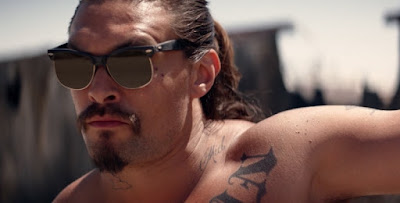Ana Lily Amirpour's sophomore feature is a potent cocktail of
layered social commentary and brutal, divisive violence. A dystopian
walkabout by way of a Millennial manifesto, The
Bad Batch, is an entrancing story about connection, consumption, and
exploitation. Featuring acid trip visuals, a pop culture drenched
soundtrack, and a unique gallery of endearing and repulsive personas,
Amirpour's second offering lacks the structural integrity of her debut, but
compensates for this deficiency with complex imagery and uncomfortable truths
about the human condition.
Arlen is deemed one of the "Bad Batch" and exiled from
the United States to a desert wasteland beyond the walls of civilized humanity.
Her odyssey of violence, love, and acceptance puts her into conflict with
merchants of flesh, both those who seek to consume it and those who would
control it. Suki Waterhouse's central performance is one of the year's
best surprises. In a time when overcompensation and operatic commitment
dominate awards season, this is a simplistic, restrained, and wonderfully
embodied turn. Waterhouse's ability to communicate the wheel of emotions,
from solemn understanding to basic human hatred, is the crux of the film.
Amirpour's script relies heavily on visuals, without support from
explanatory monologues, and while the middle act of the film delves into the
surreal, Arlen's plight and her ultimate intentions are never in question due
to Waterhouse’s intriguing portrayal.
She is supported by Jason Momoa who gives an interesting
performance as the cannibal potentate, Miami Man. While many viewers have no
doubt become accustomed to seeing Momoa shirtless, Amirpour twists the
convention of physicality into a warning sign for those who would eat you piece
by piece, as the bodybuilding savages are outlawed from the sanctuary of the
piecemeal community Comfort. Comfort's ruler is The Dream, a creepy Keanu
Reeves in one of his best performances. There's a remarkable exchange
between Reeves and Waterhouse that not only outlines the incomprehensible evil
of Reeves' Dream, but also defines the disconnect between the Boomers and Millennials,
using the extreme plausibility of a world gone mad to showcase a bifurcated
society at its absolute worst.
 |
| I'm just looking for some fish to talk to. |
Jim Carrey gives one is his best turns as a mute hermit who
wanders the wastes, saving the lives of several characters through chance,
ingenuity, and unmerciful pragmatism. His sunburned Charon ferries the
Bad Batch across a river of dust, one of the films many mythological
references. While Reeves' social media Zeus is protected by a harem of
armed (and pregnant) concubines, Giovanni Ribisi's mad prophet imparts
delirious portents and nonsensical confessions to psychedelic bacchanal.
This is the film's greatest flaw. There's almost too much to digest
in a single viewing, which could easily have the effect of turning away an
unsuspecting viewer. The plot is skin deep and the roles are ill defined,
with Amirpour trying to find common ground between the Angels and Demons of her
LSD wonderland, and this idea will either rebuke or inspire. The Bad Batch is an ambiguous exploration
of a thoughts and prayers purgatory, where the only thing of value is flesh.
While the cannibals use it as sustenance. The Dream peddles it as a form
of control and immortality, ensuring generations of would-be protectors for
years to come. However, Amirpour throws a final theme of companionship
into the mix with an awkward love story that doesn't quite work…until it does.
Lyle Vincent's cinematography captures the two worlds of the
film in stark contrast. The baked, used-up realm of the desert is filled
with wide shots of lonely vistas and discarded memories of the world that left
the Batch behind while the nighttime interior shots of Comfort are neon lit
fever dreams. Undulating bodies writhe under black lights while the Dream
passes out drugs and proselytizes about the importance of his ideals. The
soundtrack features a plethora of well placed, if a tad campy, songs that keep
with the fantasy vibe. The Bad
Batch is a place where the dials are turned up so high; it’s hard to focus
on any one thing as Arlen completes her murky sojourn. Natalie O'Brien's
costume is another excellent addition, giving each of its main characters a
distinct appearance that also feels right at home in the bloody sand.
In select theaters now and available on digital on demand, The Bad Batch is one of the first truly
divisive films of 2017. Controversy over violence to minority characters
led to an uncomfortable exchange with the director and a viewer at a live Q
& A in Chicago. Many critics have cited the plot's lack of depth as a
major flaw, while others have praised the visuals and performances. The
Bad Batch begins with its heroine experiencing unthinkable trauma and then
slowly explores her personal crucible in which her injuries become unexpected strengths.
The idea of several thousand people being relegated to a lawless, open
air prison seems farfetched, but when taken in context of world where simulated
connections are on everyone's hips, the idea of exile from the herd is not only
terrifying, but also helps to define the core of The Bad Batch's message, which is ultimately about finding peace
with one’s place, no matter where life takes you. We all have our tribes and The Bad Batch is a blistering reminder
that home and family are all about perspective.
Score
-Kyle Jonathan


